Between Then and Now: the Evolution of Special and Visual Effects In Film
When Tron was released in 1982 it wowed the movie audience with its advanced scenes of virtual reality created using extensive computer graphics. This was perhaps the first use of Computer Generated Imagery (CGI) in film which, over time, changed the face of cinema to how it is today.
That same year author John Culhane published a book ‘Special Effects in Movies’ and a subsequent article in the New York Times just prior to the release of Tron, ‘Special Effects Are Revolutionizing Film’. In it he discussed how ‘technical wizardry’ is changing films and it is only the beginning.
With the impending release of Tron: Legacy, a mere 28 years after the release of the first film, this article will look back over the last three decades at the seminal films using CGI or groundbreaking visual and special effects.
Tron (1982)
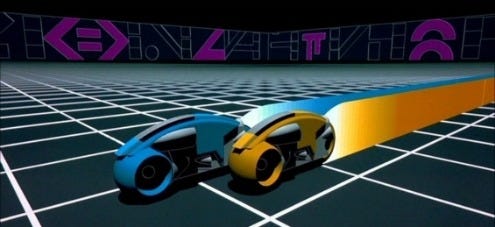
Groundbreaking at the time of its release this film combined backlit animation and inside video game virtual reality with live action. It contained the first extended use of computer generated imagery which amounted to about 20 minutes. This was mainly scenes depicting a high speed Lightcycle race created by legendary artists Syd Mead who also designed the Solaco spaceship in Alien 3 and Jean ‘Moebius’ Giraud a conceptual artist for The Abyss and designer forThe Fifth Element.
Young Sherlock Holmes (1985)

Despite losing out to Cocoon in the Academy Award for Best Visual Effects this Spielberg produced film has the first computer generated or photorealistic animated character in a feature film. A stained glass knight freakily comes to life in a church to engage in sword play, compositing a computer generated image with a live action background. Other special effects of note: a stop motion chicken and cakes that come to life.
Aliens (1986)
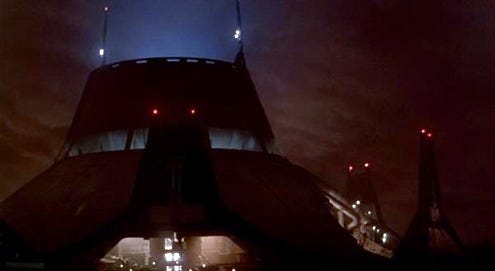
A year later this sequel to Ridley Scott’s Alien was released, winning the Academy Award for Best Visual Effects. A miniature set was built to create the colony on LV-426 and special effects post production to give a much larger appearance. These effects included rear projection, mirrors and camera splitters. A beam-splitter was used to bring together many other elements that form the whole look of the scenes in the movie which include models, matte paintings and live action.
Who Framed Roger Rabbit? (1988)

Hand drawn and painted animated imagery was matched to live action of real characters in this defining moment for visual effects. Directed by Robert Zemeckis and animated by Richard Williams this film won the Academy Award for Best Achievement in Visual Effects. The hand drawn characters were shaded and light and shadow was used to make them more 3D and life like. Industrial Light and Magic (ILM) the visual effects studio created the blue screen effects of Toontown.
The Abyss (1989)

Here, the first example of underwater CGI effects in scenes involving the ‘pseudopod’, an underwater snake like creature that moves through the submarine and imitates Dr Linsey Brigman’s facial expressions (Mary Elizabeth Mastrantonio). Lasting only 75 seconds this was the culmination of over 8 months of work. ILM featured again to create the kinetic properties for the pseudopod. They also teamed up with Dream Quest Images who were responsible for the motion control work of the pseudopod.
Back to the Future Part II (1989)
Advances in visual effects allowed Michael J. Fox to appear in the same scene simultaneously. ILM used split screen photography and a moving boundary between each section of the screen to allow Fox to play three characters at the same time, sitting at a kitchen table eating pizza. The end result was that the seams between each one were flawless, as you can see below. A VistaGuide motion control camera system allowed camera movement to be incorporated in a scene of this nature for the first time.
The Rescuers Down Under (1990)

Disney’s sequel to The Rescuer’s was the first animated feature assembled and created completely in a digital environment. A new Computer Animation Production System (CAPS) was used to scan in the animators drawings and fill them in with digital ink and paint, making hand painted cels obsolete.
Terminator 2: Judgement Day (1991)
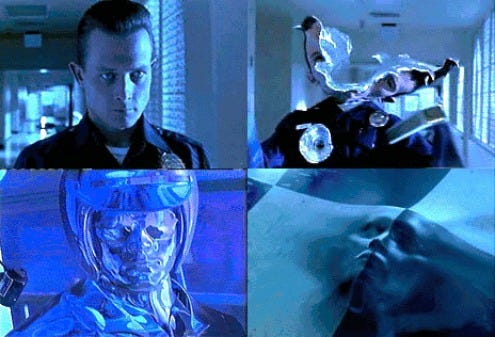
Scenes involving the new terminator, the T-1000, composed of a polymimetic metal, displayed the first extensive use of morphing and warping techniques on a major character in film. The liquid to solid texture was achieved by layering over a CG model. Despite the film winning the Academy Award and BAFTA for Special and Visual Effects the techniques used in the film added a unique element to the new terminator.
The Lawnmower Man (1992)
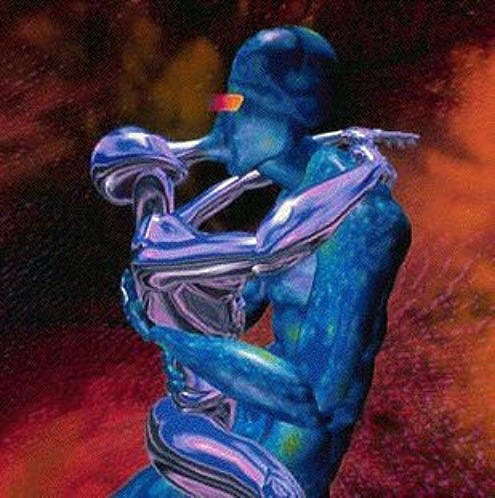
The graphics used in the virtual reality scenes here are similar in look to those used in Tron, released ten years earlier. However it was the first film to use Body Motion Capture to record the actor’s movements with a body suit. This was particularly effective in the cybersex scene with Marnie Burke (Jenny Wright) and Jobe Smith (Jeff Fahey) who had to wear bodysuits, gloves and head mounted displays (HMD).
Toy Story (1995)

Pixar and Disney clubbed together to create the first full length feature film made entirely by computer animation. John Lasseter and his team of 110 animators strived to make the film as realistic as possible, adding detail to every object. In total there were 114, 240 frames of animation, between 2 and 15 hours was spent on each one.
Titanic (1997)

Cameron is back once more and becoming a cornerstone himself in the field of special and visual effects. The pioneering developments in digital technology he used in The Abyss and Terminator 2 were taken further in this adaptation. A 14 metre long model of the HMS Titanic was built and split in two during the sinking sequence, with computer effects added post production. After stuntmen were injured falling off a large scale model of the ship characters falling off the boat were digitally inserted instead. Other effects of note include Kate Winslet’s digitally inserted iris morphing into Gloria Stuart’s eye and transition shots between the recreated ship and the one underwater.
The Matrix (1999)

The representation of virtual reality takes a turn for the better with the development of ‘Bullet Time’ and ‘flow-mo’. Using a combination of actors on wires, motion capture and filming segments of fight scenes at different camera angles the actors would appear suspended in the air mid action. Still cameras were used to take segment shots and were sequenced together, giving the effect of seeing two-dimensional slices of a three-dimensional moment. This was expanded by the Wachowski’s and visual effects supervisor John Gaeta so that rather than being frozen in time the scene moved at a very slow rate.
The Lord of the Rings (2001)
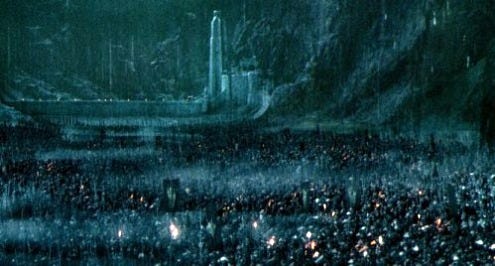
In the battle scene at the beginning of the film a CGI system named MASSIVE enabled thousands of individual characters to appear and act independently. This technique was used in the subsequent two sequels. In order for each main character to appear at their correct height forced perspective was used in scenes between Men and Elves. Scenes were filmed separately at Bag End between Frodo (Elijah Wood) and Gandalf (Ian McKellen) at two different scales. Extensive use of make up, digital and special effects were used throughout the whole trilogy, making the mythical lands of Middle Earth and the people in it come to life, as if they were a real part of history.
The Polar Express (2004)
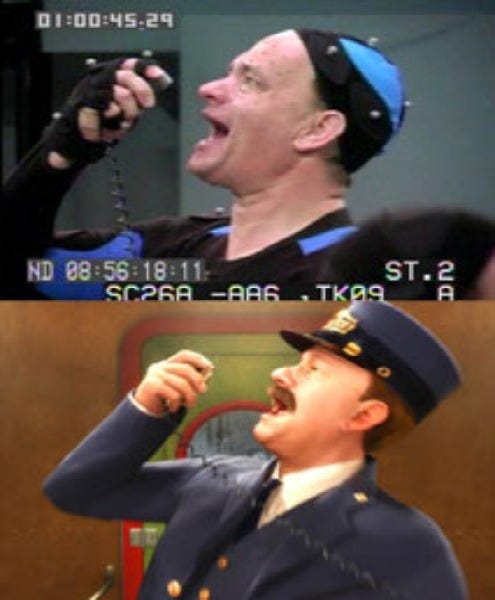
Robert Zemeckis took Peter Jackson’s performance capture technology and used it in an all digital film. Every character was created by taking the live performance from the actor and digitally capturing them using computerised cameras. The effect was a three dimensional representation of their movements. In The Polar Express Tom Hanks was able to play multiple characters include the Conductor, the boy and a hobo.
300 (2006)

A whole film was re imagined from Frank Miller’s comic book of the Battle of Thermopylae using blue screen technology. Using a super-imposition chroma key technique the actors performed in front of screens and then background was filled in using 1,500 CG shots. In post production more than ten special effects companies used shades of light and dark and desaturation to establish different moods.
Avatar (2009)

The latest step in the visual and special effects evolutionary tale. James Cameron, of course, makes all his 3D dreams come true in this science fiction/romance film. Over the years Cameron designed a dual-function camera that was able to film 2 and 3D simultaneously. Combined with the best that motion capture had to offer this marks Avatar as one of the greatest milestones in visual effects technology, despite the overused storyline. Characters such as Gollum, King Kong and Davy Jones from Pirates of the Caribbean film series enabled Cameron’s dream to properly take flight.
Tron: Legacy (2010)

Watching the two Tron trailers back to back you can see the stunning visual differences between the two. 28 years later the visual effects are striking, with smooth lines and amazing depth in each scene. Filmed entirely in 3D this long awaited cult sequel also features 7.1 surround sound.


